The listings will continue until people can afford houses in places they want to live.
New City By the Bay, Who Dis
They want to live in San Francisco, but San Francisco has no interest in building homes. What to do? The city’s answer is to spend massively to support its homeless population, causing it to grow, while letting the housing shortage get worse. Some tech billionaires instead propose to go to Solano 60 miles away, and start the initiative California Forever on 55k acres to build a new city. We have our first look at what they are imagining, and it looks like an old school Greek or Italian village. Quite nice actually, skipping straight to the future NIMBY world with one extra town in it is already hugely profitable and helpful.
That still wouldn’t have been my move. I would have gone Chinese megacity on everyone. Why not build skyscrapers off the bat, or at least New York style twelve story apartment buildings, and plan the place accordingly? Get some real bang for your buck. Even in the ultimate YIMBY, the NIMBY spirit lives on. That’s before the new residents of the new town start to weigh in.
Scott Alexander covers the issue in California Dreaming. He sees quite a lot of logistical and regulatory obstacles to making this work even as a Norman Rockwell villa. The (tiny) predict market has them at a 15% chance to get 5,000 residents by 2030.
Housing is Expensive
Despite housing costs that look increasingly unaffordable, Noah Smith joins the chorus of those confused by the other chorus that complains about unaffordable housing costs and how Millennials can’t afford homes.
David Atkins: The utterly broken, boomer-dominated housing market is the #1 reason people under 45 are miserable, think the economy is awful and are seeking some sort of revolutionary change.
It is absolutely absurd that people of retirement age are the biggest segment of home buyers, while people with young families are locked out of housing. It has never been this way before, and it is totally incompatible with actual human needs.
Washington Post: The median age of a first-time home buyer climbs to 36, as high interest rates and asking prices further erode spending power.
Noah Smith: I just don’t understand this narrative. The difference in homeownership between the generations is VERY small, and can probably be completely explained by Millennials staying in school a little longer.
Homeownership rate for people under 35 isn’t at an all-time high, but it’s higher than it was in the early 90s!
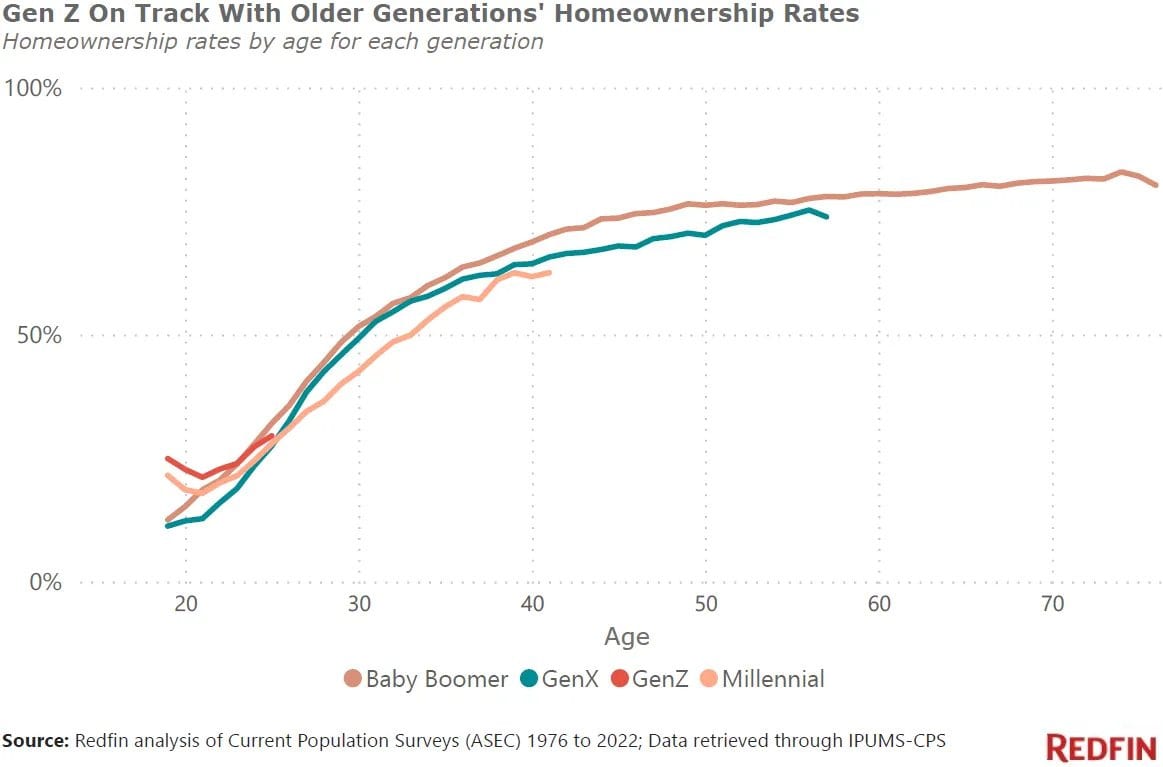
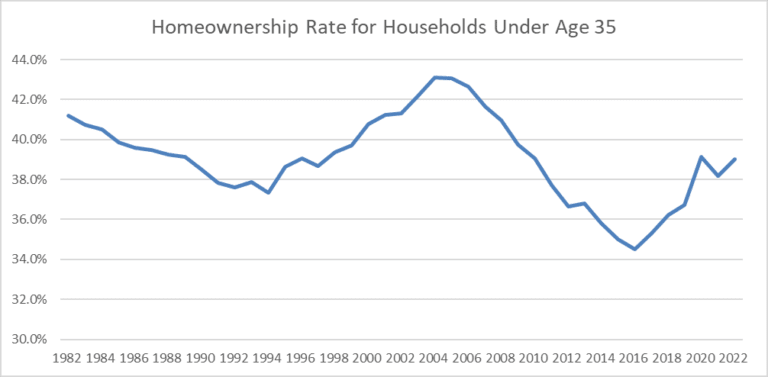
There is little doubt that housing has become more expensive. This first official graph is not indexed for inflation, but the statistics that are tell the same story, and the second graph does do the comparison.


You have to live somewhere. In many places the rental market is at best thin. Home ownership rates have not declined much because many will respond by buying and living in a smaller house, or one in a much worse location, or most importantly by having fewer children. I don’t think you can understand the housing cost problem or declining fertility without considering both.
Here are more statistical observations that people continue to find ways to own homes.
WSBChairman: The average US home price is $348,853, yet 57% of Americans have less than $10,000 in their savings account. Owning a home is no longer possible for the majority of Americans.
Twitter Community Note: According to the Census Bureau, the vast majority of Americans (65.8% of US households) live in a home that they own. The home ownership rate continues to increase, and is currently higher than it was before the start of the pandemic.
Matt Darling (in another thread responding to a different statistic claiming 40% of US Adults have less than $1k of savings): As of 2019, the median household in the United States had: – A net worth of $121,760 – $26,000 in financial assets – $5,300 in transaction (checking/savings) accounts. This survey is just clickbait nonsense.
James Medlock (original thread): “Owning a home is no longer possible for the majority of Americans” is a weird claim to make when the majority of Americans currently own a home.
That also does not mean that in the near past things were better.
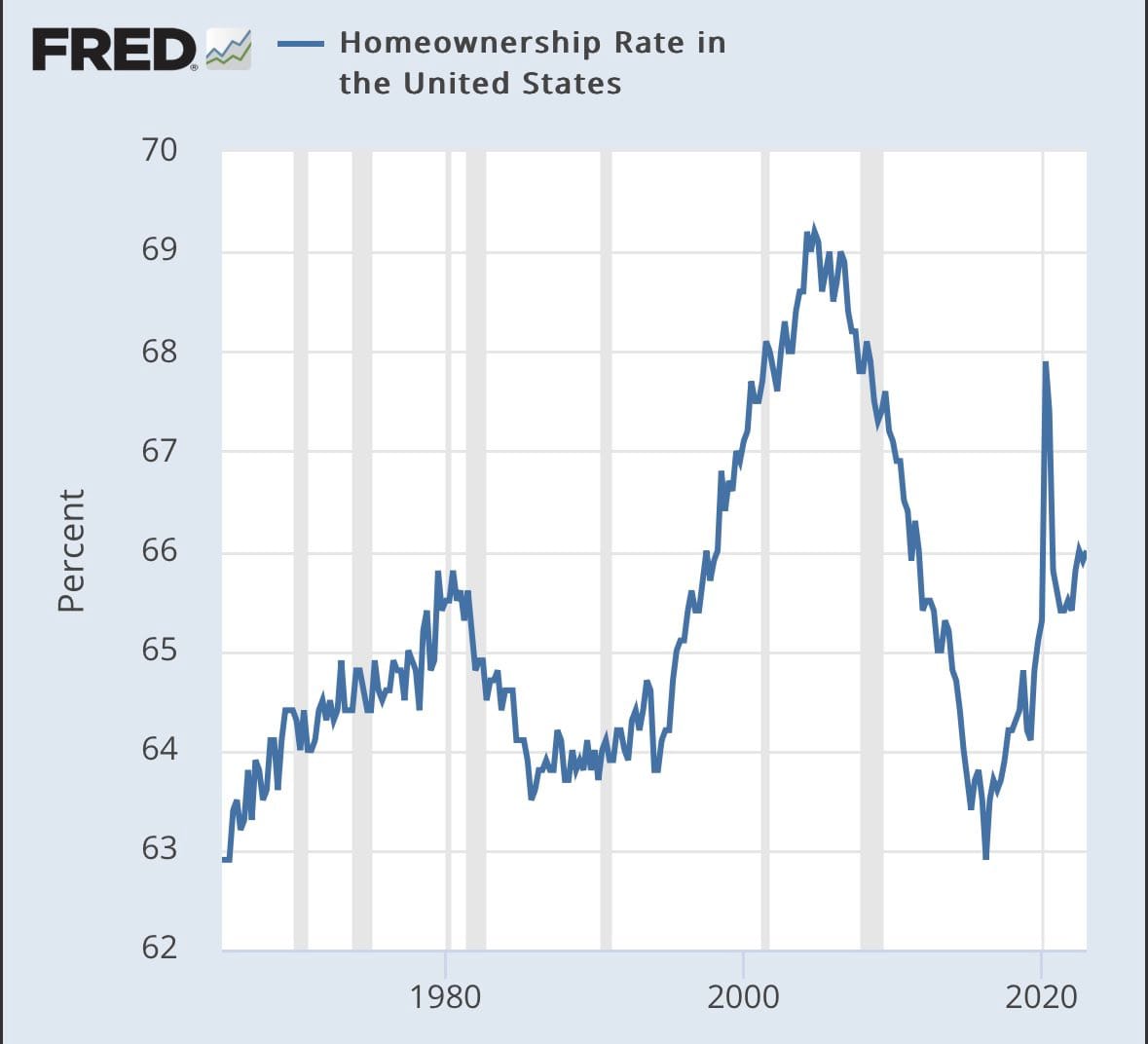
If you go back to the era of the homestead act, I presume the statistics (which we don’t have) would show much higher rates, but within our lifetimes this is the trend.
So most of us do find a way to own, or live with someone who does. Yet the intended message could easily be importantly true, in the sense that the majority of Americans, if they needed a house, would be unable to purchase one. They might live with someone who owns one, perhaps their parents or spouse. They might happen to already own one, which is a gray area, due to either inheritance, family assistance or getting in early. But if they had to go from renter to owner, they would be unable to do that, certainly unable to do that quickly.
Also a lot of people are making huge life sacrifices on this alter. If you don’t have children because you can’t afford a house that would fit them, you can’t afford housing. If you are paying 50% of your income on housing and you have no savings otherwise because of this, there is a real sense in which that is unaffordable, even if you ‘afford’ it anyway, especially if that also means no kids.
GPT-4 estimates that, if they needed to within a year, only 10%-20% of non-homeowners would be capable of buying a home. That seems right.
Recently the situation has gotten much worse. The cost to buy a house right now does not look sustainable. Then again, what exactly would prevent it from being so?
Mike Bergmann: What a monthly mortgage payment would look like for a new home buyer in the US, based on the median existing home price and the average 30Y fixed-rate mortgage, assuming a 20% down payment. Not including taxes and insurance – and this isn’t a 3.5% down buyer with added mortgage insurance either.
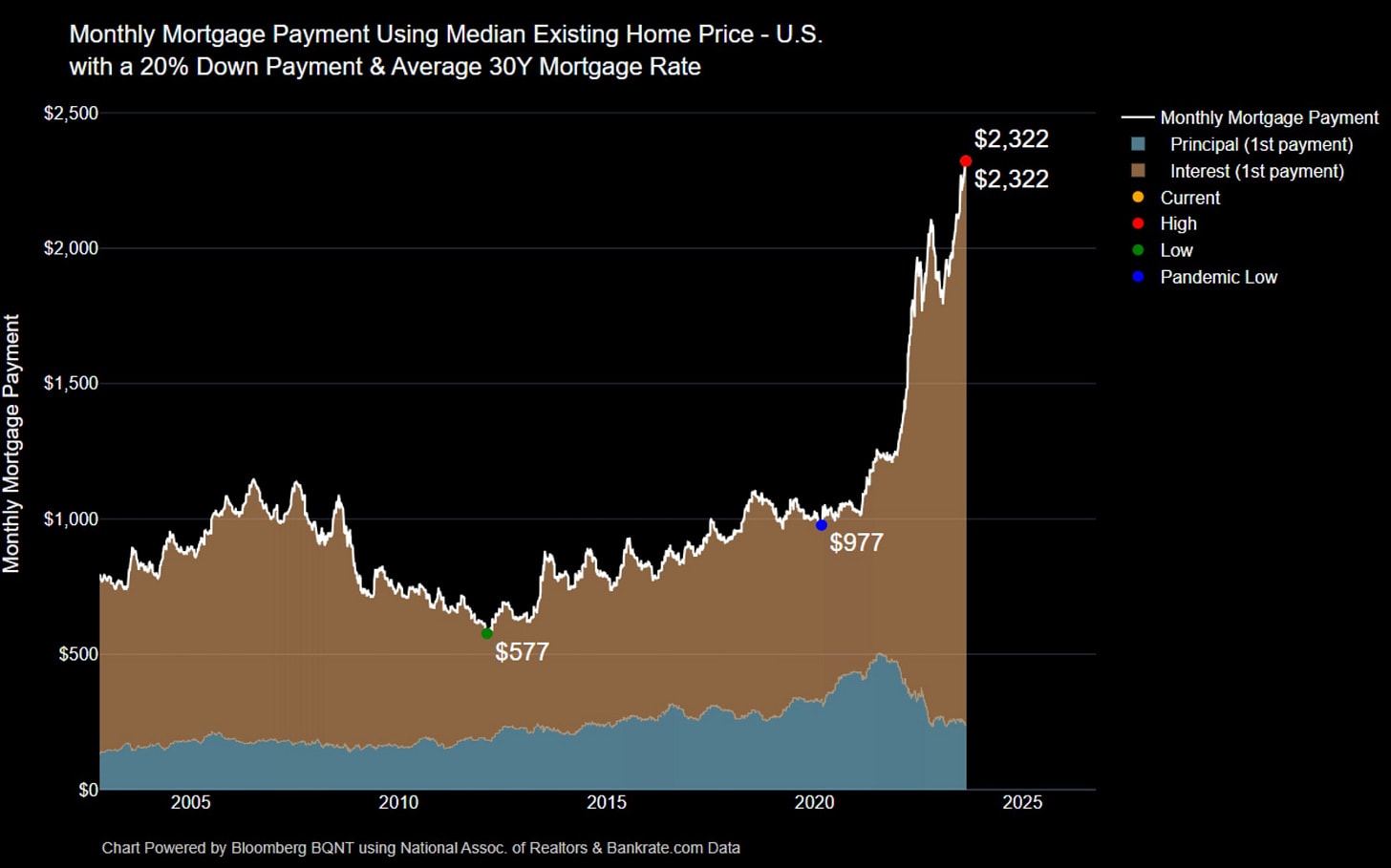
American median household income was $70,784 in 2021. After federal taxes, that’s $57k or so, add in state and local and the average is maybe $52k. Could one spend $28k of that on housing? I mean, one could, although it is dicey. If there are substantial additional costs to homeownership, and there are, then it rapidly gets a lot dicier.
This is sustainable in the sense that nothing obviously stops it from continuing. It is not sustainable as a way to maintain a civilization. If it is sustained, it would be a disaster including a fertility collapse. And it will be no mystery why regular people think the economy is terrible, no matter how many other statistics you point to.
Redwood City charges a $47,414 ‘park impact fee’ to build a new single family home.
Emmett Shear: Resembles nothing more than a country club, with buy-in fees to keep out the poor. These fees are common around the Bay Area, because prop 13 makes using normal property taxes impossible.

I am here to give the contrarian take and say this is great. Much better to tax construction than to ban it or throw up insane regulatory barriers. This helps provide the buy-in to prevent or mitigate those risks. The money goes to the city, and serves to compensate existing stakeholders. New houses pay the property taxes for everyone seems like an excellent compromise.
Deadweight losses should be minimal, reasonable decisions made. If the house is worth the extra $50k, it will get built. If it isn’t and the lot sits idle instead, then we didn’t need the house all that badly, it wasn’t adding all that much value.
Not Having Housing is Expensive
How about where they want to go to school? (direct link)
Middlebury lacks sufficient housing for all the students planning to attend this fall. After exhausting other options, the college plans to pay 30 students $10,000 each to stay away.
The problem is that time off for Covid led to an unusually high number of students trying to finish all at once. The story is about the lack of housing solutions, but it seems like this would also create other issues around things like class sizes.
Students might not realize that taking a semester off could cause them to graduate later than they had planned—if, for instance, their major requires a course that is only offered in the fall.
If that isn’t an issue and a student can catch back up, then this seems like a fantastic deal. The $10,000 is no small thing. Then there are a bunch of complaints about why money isn’t being spent elsewhere or that less well off people might be more likely to give something up in exchange for payment of money.
College towns are not typically in the habits of helping students find housing. Usually quite the opposite, as StudentRentalPro notes. They will not only not let you build, often they will do things like enforce rules against too many non-related people living in the same house. Which he says were often to prevent exactly things like forming a new a group sorority house.
NIMBY vs. YIMBY
Matthew Yglesias claims YIMBYs keep winning, below the paywall is a list of 122 discrete successes. Things are definitely going better than I would have expected. The big wins that would unlock most of the value still remain elusive.
Other places, NIMBY rules (Atlantic), and residents (mainly one resident, here, but still counts since it still works) take a firm stand against such horrible offenses against their community as… trees. Also bike racks and traffic safety infrastructure. It’s about the disrespect, you see.
This is what some people actually believe and advocate for.
Patrick McKenzie: Annals of reverse culture shock: passed a sign titled Save Our Parking complaining that the relevant department was scandalously considering approving a six story apartment.
“Oh yeah, I forget, the boogeyman does unironically exist here.”
Does the boogeyman know they are the boogeyman? Plausibly they’re the hero of their own story, worried how much the world oppresses righteous boogeying.
I suppose now that I have the franchise I might have to jump on the hand grenade that is local planning meetings.
“Hiya, here representing business owners and well-paid professionals that vote. We like homes. Please build more of them. Thank you.”
“See you again in October.”
“Ah this is an interminable series of meetings designed to achieve victory through sheer exhaustion? As a recovering Japanese salaryman, I’d recommend beginning with a 149 page PowerPoint deck distributed on paper as an agenda.”
Adam Singer: Computer, encapsulate the NIMBY spirit in a single headline for me would you.

NIMBYs weaponize actively anti-environmental environmental laws, forcing Minneapolis via lawsuits to reverse its ban on single family zoning. The concerns given as justifications are rather absurd as complaints, and have little to do with what a normal person would call the environment. The YIMBY side cites that this is going to make things far worse for poor people, barely mentions it also will make it worse for everyone else, and they do not mention that it will be awful for the environment. Denser housing and more people living in cities is far less carbon intensive than the alternative and helps save the planet. Yet it does not superficially look green, it is not symbolically green, and it does not force anyone to suffer, and considerations like that seem to be what mostly matters to such folks, so they work to actively make things worse.
Building Houses Where People Want to Live
Gary Winslett: Something I think people overlook: this also helps people looking to buy single family homes because it makes it easier for seniors/empty-nesters to downsize from their single family home to an easier-to-upkeep single-level apartment, thus freeing up that single family home.
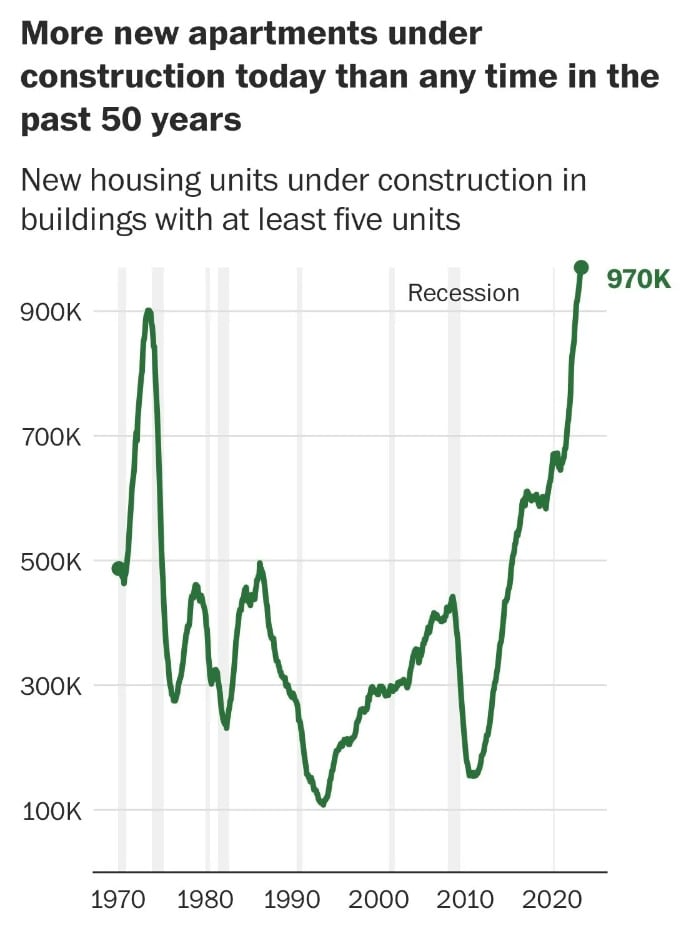
Chartr: “The US is on course to complete construction on over 460,000 new apartment units in 2023 — the highest figure on record”
The number is not population-adjusted. Still, look at these differences.
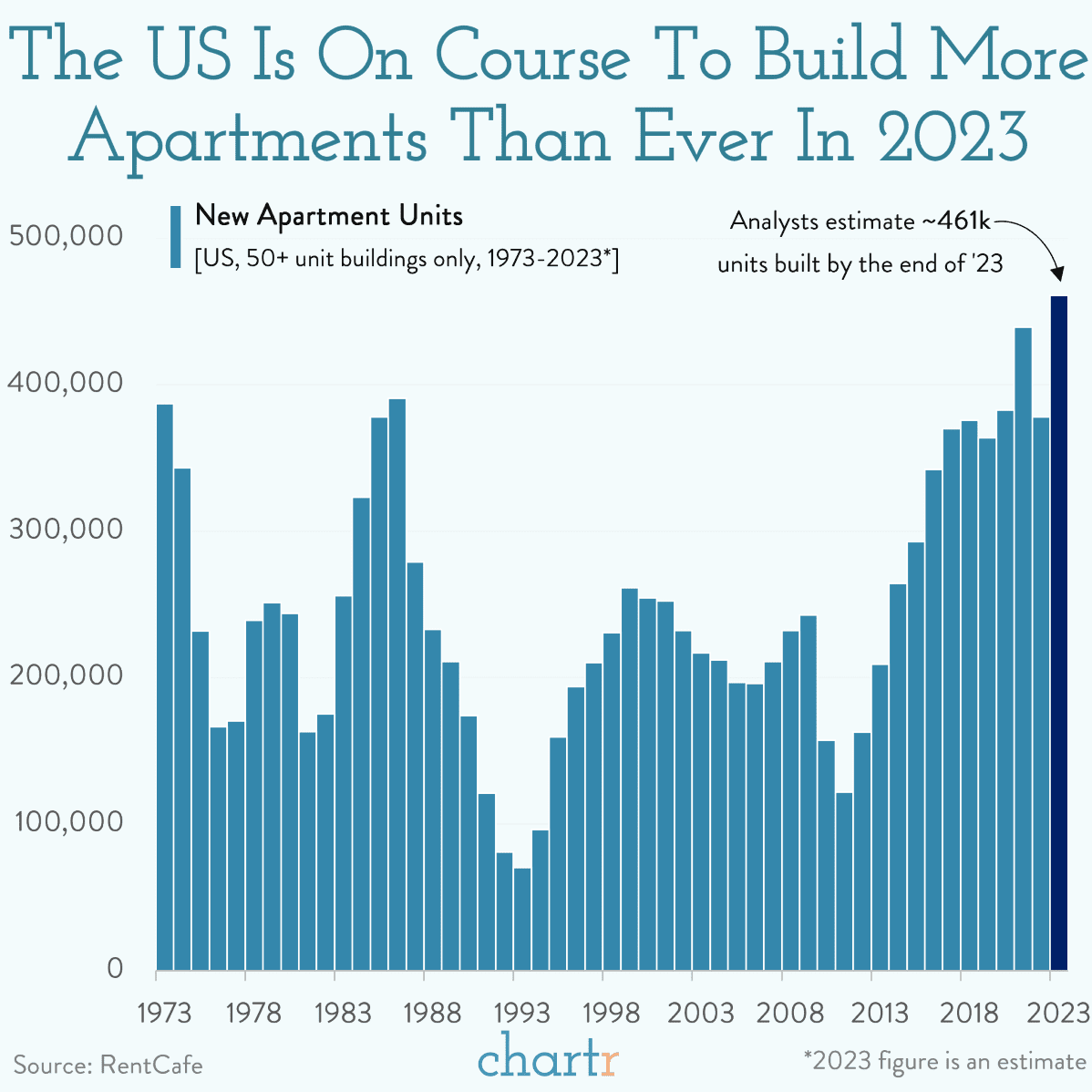
Let’s keep up the momentum.
Also back would be NYC’s Midtown if this goes through (Bloomberg), a rezoning plan to convert vacant offices into as many as 20,000 new housing units, by extending the opportunity to any buildings built before 1990, up from previous cutoffs of 1961 and 1977, covering an additional 136 million square feet, roughly the total office space in Philadelphia, as well as conversions anywhere you could have built housing in the first place. There will also be an area rezoning to mixed residential-commercial for 23rd street to 40th street, fifth to eighth avenue. So to affirm that I walk the walk: YIMBY. Literally YIMBY.
Hawaii also attempts to be so back. Governor of Hawaii evoked emergency powers to streamline the housing development process (direct link, note this proceeded and is unrelated to the actual emergency last month, which is the type of event ‘emergency powers’ are intended to handle).
Jane Lyons-Raeder: The governor of Hawaii has evoked emergency powers to streamline the development approvals process. “Let me break it down for you. We don’t have enough houses for our people. It’s really that simple.”
Governor Josh Green: If it’s not a crisis, if it’s not an emergency, I don’t know what is.
The proclamation addresses many of these these barriers by removing them. The order replaces state and county agencies in charge of administering land use and environmental programs with a lead housing officer and a 22-person panel called the Build Beyond Barriers Working Group. Nani Medeiros, Hawaii’s chief housing officer, will serve as lead housing officer.
I am torn. On the one hand, that is not what the word ‘emergency’ (or ‘crisis’) means. We do not have a Housing Emergency, almost all of the declared or supposed ‘emergencies’ are not in fact emergencies, stop saying everything is an emergency. The Covid ‘emergency powers’ uses mostly were well-intentioned but showed we are not a nation of laws or one where words have meaning. I get emails claiming New York has a ‘blood emergency’ yet it is not such an emergency that one can show up to donate without an appointment, or get an appointment until two days later. And so on.
On the other hand, the housing situation is completely out of control and measures like this are necessary to fix it.
It certainly is better than his proposal to temporarily block permit-issuing in the wake of the wildfires, in order to destroy the value of the land so locals won’t sell it. If selling your land is your only recourse in the wake of a disaster, and the Governor blocks that from happening, is he going to provide an alternative recourse?
California extends the lifetime of SB 35 via SB 423. SB 35 streamlined permitting for mixed-income housing in jurisdictions that are falling out of compliance with state housing law.. Nolan Gray calls this victory absolutely massive, I would not go that far but it certainly is good news.
In Newsweek, AEI’s Edward Pinto comes out in favor of light touch density.
Edward Pinto: But there is a simple solution to the problem. The answer to our housing crisis is to legalize duplexes, triplexes, and other forms of light-touch density (LTD) housing, allowing the market to build more affordable housing options for more Americans.
…
This is already happening across the nation. California, Austin, and Vermont have each passed legislation entitled HOME. In California, it stands for Housing Opportunity and More Efficiency; in Austin, Home Options for Middle-Income Empowerment, and in Vermont, Housing Opportunities Made for Everyone. What these and other enactments have in common is a recognition that the solution to our nation’s worsening housing crunch is to repeal zoning laws that only allow the building of single family detached housing.
…
By implementing by-right LTD across the country, an estimated 930,000 additional housing units could be created annually (depending on the maximum allowed density) over the next 30 to 40 years.
This would not solve our biggest issues, especially in the places we need more housing the most like NYC and SF. We still need not-so-light-touch density measures. It would still be a big help to allow incrementally more housing elsewhere, as opposed to intentionally driving prices up to keep undesirables away.
Biden administration announces new steps to lower housing costs and boost supply.
The newly announced plan will leverage three separate areas toward achieving this goal: Easing land use and zoning rules, expanding financing and promoting the conversion of commercial to residential space.
There is a very everything-bagel flavor here, which is almost never useful:
On financing, the administration is rolling out a $27 billion fund via the Environmental Protection Agency for energy efficient and climate resilient housing.
Also this does not tackle the big issues, and the sizing for the other programs seems likely to be miniscule, and they are relying on subsidies to convince municipalities to change their laws. There are much more effective tools available if the administration wanted to spend political capital on looking weird. This still does seem like it is better than doing nothing.
Overall, we’re somewhat back, definitely not all that back. Journalists quote a Harvard study as saying we have a 50-year high in housing construction, without noting that we also have 100 million more people to build houses for. The report says there is a national shortage, reporting on it says there’s a surplus. Sigh. As report recommends, we need more houses in places people want to live, as well as ones that people can afford, which is highly causally related.
Georgist Redux
Tyler Cowen suggested caution on land value taxes a while back and I never got around to publishing my response.
Here are his central objections.
Yet I hesitate. Theories, even compelling ones, can take you only so far. Practically speaking, a hardcore land-value tax feels too simplistic.
A land tax is only being talked about because urban planning is so broken, serving too many interests other than those of ordinary middle-class residents.
…
I can predict what will come out of that meat grinder: a policy to compensate current landholders, one way or another, for the land tax. So if Palo Alto introduces a land tax, it likely that the revenue will go back to those very same NIMBY interest groups.
…Keep in mind that a lot of people rely on rent and land revenue to stay solvent, so it is quite likely that they will argue on “fairness” grounds that they should be grandfathered in and exempt from the land tax.
…
It’s not the tax system that drives high rents and NIMBYism; it’s the power of interest groups. Even with a pure land-value tax, that power won’t just go away.
As far as such classes of argument can go, I find the ‘this will never pass or require massive bribes that invalidate it’ compelling in practice, although not in new as yet properly developed areas. I say we should do it anyway, even if it did require massive compensation, partial exemptions or even full exemptions. A long term phase-in for existing stakeholders would still get the job mostly done over time.
And yes, urban planning is broken in many big ways that this would not directly address. Yet it would address it in the sense that a land tax reverses or neutralizes the incentives driving those interest groups. If I am bleeding a ton of money each year on land value taxes, perhaps I would not be so strident in preserving that status quo instead of taking advantage of the value of that land.
There is a missing mood here. Rather than treat this as ‘yes the case is overwhelming, this is the right thing to do even if it is not practical’ it is treated as not the right thing. I find that strange.
I can think of good objections that have nothing to do with the difficulty passing the required laws, that I don’t have great answers to, but as usual I see no sign of them.
Megan McArdle calls it an important column, calling upon us to consider what a practical implementation would look like. This seems like another objection of the form ‘this would work so we won’t do it, or if we did do it power would simply confiscate our whole surplus again.’ She says that those fighting to eat the surplus for themselves do not go away, they simply take another form, its power immortal.
This does not seem like a good reason to try and stop power from confiscating our whole surplus. It does make the job more difficult, an eternal struggle.
I also think it isn’t entirely true. It is somewhat true, yes if you cut off one avenue they will seek another one. However, if your shutting down that avenue gives them less incentive to fight for, less to protect, they will respond accordingly. If you take away the profits from the unimproved value of land, or make other changes, it can shift the further incentives of insiders.
One can make essentially six objections to a land value tax, listed in order of how much they refute the central point if true.
- It won’t work.
- It would work, but you can’t suddenly impose confiscatory taxes.
- It would work, but not in practice given implementation.
- It would work, but it would be weird and upset power.
- It would work, but we won’t do it, so stop wasting your time.
- It would work, but wouldn’t solve all problems, so why do it?
The objections I saw made are mostly I see #5 (with some #3 and a little #4 mixed in), a hopeless ‘NIMBY interests control cities and will steal the entire surplus for themselves regardless.’ Well, yes. If NIMBY interests control your city, you aren’t passing a land value tax, and if you nominally do pass one it is not going to count – if you exempt everyone who would pay, or you return the money to those who paid, you didn’t implement much of a tax.
The best objection, #1, is rarely offered and was not present here. Nor do I see the principled case for #2, which seems like the strongest objection. It’s not only that people would demand exemptions because they are collecting rent, which is part of numbers three to five, it is that this is a massive confiscation of property, a total one if the tax rate as is traditionally proposed approaches 100%.
Also at 100% the tax will have people actively trying to destroy the unimproved value of their own land, a new mutant NIMBY form that could be even stronger than current models.
Thus I strongly think both it would be unwise for the tax to approach anywhere near 100%, and one does not want to hit existing stakeholders with the full tax all at once on existing value.
Instead, in an ideal world, I am now more or less a half-Georgian, although it is a much more lightly held and lightly considered position than I would want before actually implementing such a thing. I want to aim for more like a 50% tax on the unimproved value of land, with existing land values phased in gradually over a long (20-50 year) period, with any increases taxed fully right away.
Rent Control
Where ‘get rid of rent control’ gets implemented, it keeps working.
California YIMBY: A massive housing supply increase in Minneapolis has cut rent growth almost to zero (Bloomberg, 1% rent increase since 2017 versus 31% for USA).
Aaron: okay, so it worked in Minneapolis and New Zealand and it works in Japan and Houston but how do we know it will work *here*?
Yet they never learn. Germany’s ruling party plans rent controls. Insert your own joke about aerial bombing. Continuously I get happier with my decision to have my stock portfolio entirely exclude Europe.
Traffic
Ah, the old ‘this plan doesn’t do enough so we will spend more instead in a way that won’t do anything at all.’
Nolan Hicks: [Exclusive]: The MTA shelved a through-running/signals program that could have boosted Penn Station’s capacity by 20-45%. Officials say they shelved it because it missed capacity targets. The $13B terminal they’ve proposed instead misses those targets, too.
NY Post: The Metropolitan Transportation Authority and New Jersey Transit shelved a $3 billion plan to boost the number of trains running through Penn Station in favor of a pricy $13 billion expansion of the decrepit transit hub — in part, to avoid working together.
…
Stunned transit experts said it appeared the railroads favored the expansion because it would allow them to maintain their fiefdoms and avoid further integrating their Penn Station operations.
I mean, would you want to work with the MTA or NJ Transit? So it makes sense.